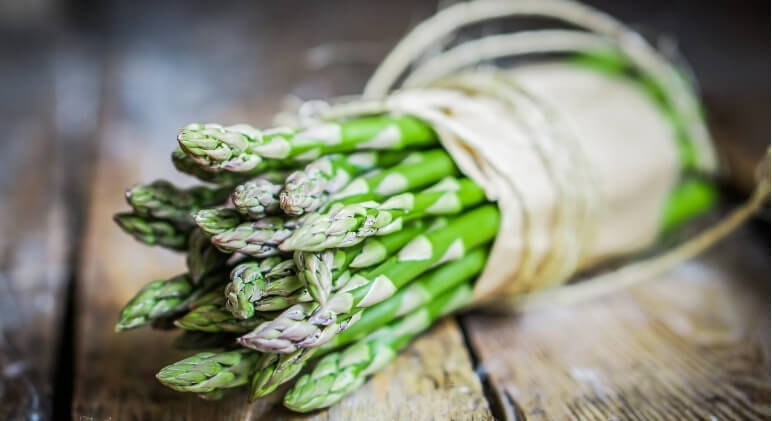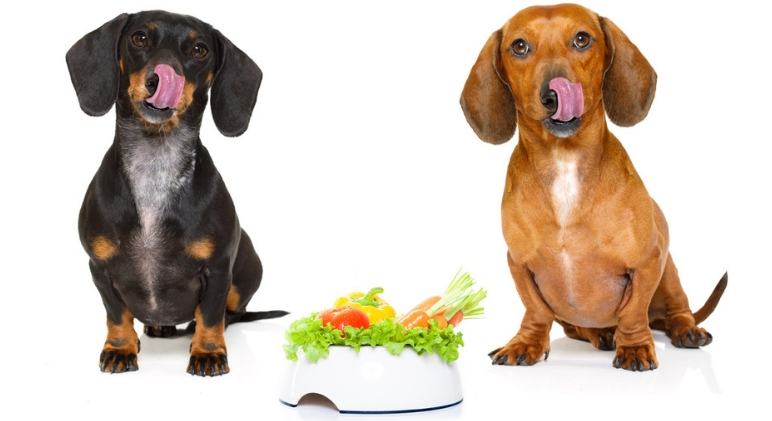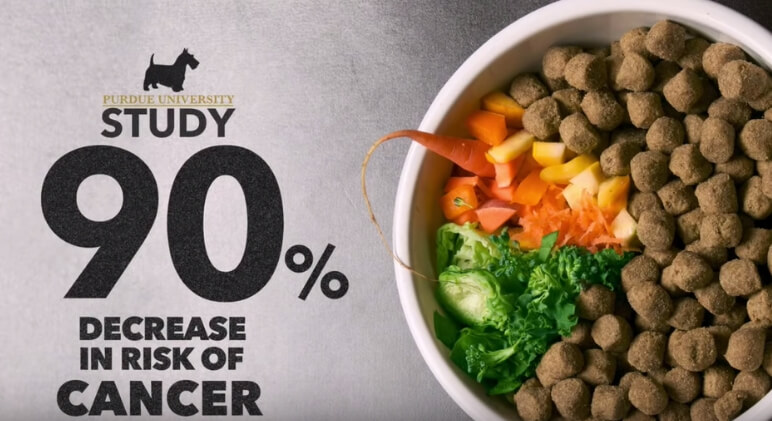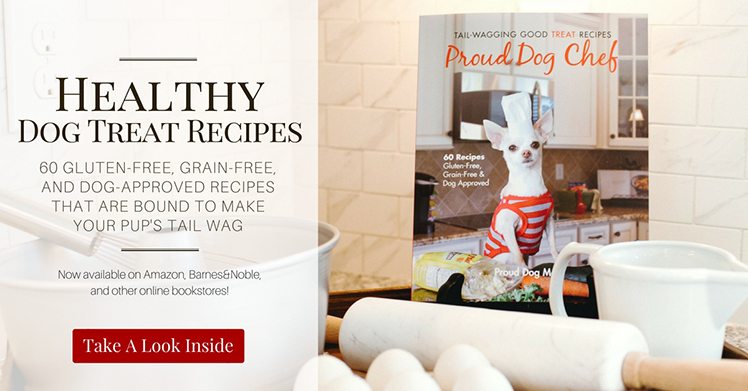Have you ever watched pet nutrition blogger Rodney Habib’s TEDx Talk called “Why Don’t Dogs Live Forever?” In the eye-opening 15-minute video, Rodney shares research and findings that talk about how a fresh food diet impacts our dogs’ health.
During his presentation (which you can watch here), he quoted a 2005 Purdue University study that asked the question: How does adding a little bit of fresh food to a bowl of processed dog food impact dogs? In the study, dogs ate dry commercial pet food and, at least 3 times a week, some got an assortment of vegetables added to their bowls.
The results?
Dogs who ate any green leafy vegetables had reduced the risk of developing bladder cancer by 90%. Dogs who consumed any yellow-orange vegetables like carrots reduced the risk by 70%!
Adding certain fresh foods to our dog’s diet can have a huge impact on their health. While I often talk about the benefits of various fresh foods — like carrots, red bell peppers, blueberries, strawberries, etc. — today, we’re focusing on green veggies!
So, here you have it, 7 green veggies that dogs can eat:
1. Broccoli
Broccoli is a low-calorie, nutrient-dense, cruciferous vegetable related to Brussels sprouts, cabbage, cauliflower, and kale. It boasts anti-inflammatory properties, benefits digestion, and even contains compounds that reportedly protect against cancer. In fact, lately, there’s been a lot of talk in the dog community about broccoli’s anti-cancer properties.
How to add it to your dog’s diet: Dogs can eat broccoli either raw or cooked. But, it’s important to note, raw broccoli is harder for dogs to digest. So, steamed or lightly cooked is best!
If you feed a fresh, home-cooked diet, you can easily work finely chopped-up broccoli into your pup’s main meals. If you feed a processed kibble diet, adding some fresh broccoli bits is a great way to bump up the nutritional value.
Broccoli also makes a great dog treat. If your dog likes broccoli straight up then a bite-size piece makes a great treat. Or, you can mix it into a treat recipe, like my Salmon Broccoli Muffins or Frittata Puppy Muffins.

2. Spinach
Whenever I eat spinach, I think of Popeye. I can picture the little cartoon right now – a sailor with big arm muscles, reaching for a can of spinach to help him stay super strong! This popular leafy green is a nutritional powerhouse that offers up a variety of key vitamins, minerals, and antioxidants that aren’t only beneficial for people, but Fido too!
How to add it to your dog’s diet: Experts recommend buying organic spinach and washing it well before feeding it to your dog (or you!). When preparing it for your pooch, the best is to chop it (or, better yet, puree it) and steam it. Boiled spinach is said to lose most of its nutrients, and raw spinach can be more difficult for our dogs to digest.
Add a little steamed spinach to your pup’s meals or chop it up and add to homemade treats. I like adding them to biscuits, my Puppy Frittatas, and even protein-filled bites (add some chopped spinach to these Doggy-Approved Turkey Meatballs or swap the broccoli for chopped greens in my Salmon Muffins treat).
NOTE: When adding spinach to your dog’s diet, do so in moderation. This leafy green contains oxalates, which block the body’s ability to absorb calcium and can aid in the formation of kidney and bladder stones when consumed in large quantities. While many experts agree that a dog would have to eat a very large amount of spinach to cause issues, it’s best for some dogs to avoid spinach. For example, if your pup is prone to kidney and bladder stones, spinach shouldn’t be on their menu.

3. Kale
This dark green cruciferous vegetable is rich in vitamins and antioxidants that help boost the canine immune system. The fiber content in kale can also help with their digestive health. Plus, it boasts anti-inflammatory properties.
How to add it to your dog’s diet: Experts recommend buying organic kale and washing it well before feeding it to your dog (or you!). It’s recommended to feed cooked vs raw … and avoid feeding the hard ribs.
Personally, I like to make homemade kale chips for my dogs (recipe in my cookbook, Proud Dog Chef: Tail-Wagging Good Treat Recipes). You can also use it how you would spinach — chop it up and add it to your dog’s food bowl or homemade treats.
Like spinach, kale contains oxalates. So, while kale is healthy and offers many benefits, it’s important to feed in moderation!

4. Green Beans
Low in calories yet high in nutrients (like vitamin C and magnesium), green beans are a great snack for dogs … especially overweight dogs who need to ditch those pesky pounds.
How to add it to your dog’s diet: The most important thing when serving green beans to your pooch: Make sure they’re plain. If you make them as a side for your dinner — and jazz them up with butter, salt, onion, garlic, and other seasonings — don’t share them with your pooch. Plus, those holiday green bean casseroles are a no-go, as they’re usually coated in butter, cream, mushroom soup, and onions (foods your dog should stay away from).
In moderation, dogs can have plain green beans either raw, frozen, steamed, boiled, canned, or dehydrated. With that said, raw is the hardest for them to digest, so it’s better to cook them first!
- Raw – If giving your pooch a raw green bean treat, wash and chop into bite-size pieces first to avoid a choking risk.
- Frozen – Some dogs love to gnaw on frozen green beans, especially during the summer months!
- Boiled / Steamed – These are perhaps the easiest ways for dogs to snack on them since they’re in a softened state.
- Canned – Busting open a can is perhaps most convenient for many of us. Plus, the tasty bites are already in a softened state. But, if feeding canned, make sure to check the ingredient label first. Avoid cans that have added salt, sugar, and flavors. You just want plain. To be on the safe side, you may even want to pop your canned beans into a strainer and give them a quick rinse.
- Dehydrated – A little green bean crisp makes for a fun treat. Confession: I’ve tried dehydrating them in the oven several times and they never come out good for me. Rather than crispy, they’ve always come out hard. If you have a dehydrator then you may want to give it a try!

5. Cucumbers
Cucumbers are 95% water, making them a wonderful hydrating dog snack for both you and your pooch on a hot summer day. But, that’s not the only thing they’re good for! According to Live Science: “Cucumbers contain several antioxidants, including vitamin C, beta-carotene and manganese, as well as flavonoids, triterpenes, and lignans that have anti-inflammatory properties.”
How to add it to your dog’s diet: When picking out a cucumber to share with your pooch, it’s best to opt for organic, as they do contain a high level of pesticides. Unless you’re sure that your cucumbers are organic, peel them before serving to your dogs.
Before offering cucumber to your dog, make sure to slice it to avoid a choking hazard.
A few ideas for incorporating cucumber into your dog’s diet:
- Mix a few small slices into their main meal to bump up the nutritional value
- Offer small bites as treats during training sessions
- Cut into a spear and freeze for teething puppies to gnaw on
- Thinly slice into rounds and put into a dehydrator to create a crunchy chip to share with Fido
Overfeeding may result in tummy upset. As with any new food, introduce it slowly into your dog’s diet to see how he handles it. If you have any questions or concerns, consult with your veterinarian.

6. Brussels Sprouts
Brussels sprouts are a cruciferous vegetable that resembles mini cabbages. They’re a member of the Brassicaceae family of vegetables, meaning they’re closely related to other powerful superfoods, like kale and broccoli. Like their close relatives, they offer up a variety of key vitamins, minerals, and antioxidants that benefit both us and our canine companions. Of course, before you simply toss Brussels sprouts to your pup, it’s important to know the proper feeding tips.
How to add it to your dog’s diet:
- Avoid feeding raw, as they’re hard for dogs to digest. Rather, you’ll want to boil or steam them first.
- Cut them into small, bite-size pieces to avoid a choking hazard.
- While you may like to jazz up your serving of sprouts with various seasonings, keep your pup’s helping plain.
- Only feed Brussels sprouts in moderation. Canine nutrition experts say veggies, like Brussels, should make up less than 10% of your dog’s diet. So what is 10%? Well, that depends on your dog’s size. In general, a couple of bite-sized pieces are totally fine and healthy! If your pup gets gassy then cut back!

7. Asparagus
Steamed, roasted, or grilled — asparagus is a versatile and popular side dish that many people enjoy. Not only is this spear-shaped veggie filled with flavor, but it’s also loaded with beneficial nutrients that support a strong immune system, help detox the body, may aid healthy digestion, support eye health, and more.
The answer to a popular question: You know how when you eat asparagus, your urine has a pungent odor? Well, this will also happen to your dog. If your pup is potty trained to go outside then you likely won’t notice or have an issue with it!
How to add it to your dog’s diet:
- Trim off the rough, fibrous end of the stalk
- Cook asparagus until it’s tender! We don’t eat raw asparagus for a reason – it’s tough, hard to chew, and difficult to digest. Well, it’s the same thing for dogs. So, when feeding asparagus to your dog, make sure to lightly cook it first, until it’s soft and easy to eat. Simply steaming or boiling this veggie is perfect!
- When cooking asparagus for your dog, don’t add any extra butter, cooking oils, or seasonings. Just serve it plain.
- Cut into bite-size pieces before adding asparagus to your dog’s food bowl or offering as a treat to avoid a choking risk.
- Feed asparagus to your dog in moderation. If overfed, it may cause an upset tummy and gas.
NOTE: While asparagus is fine for dogs in moderation, the asparagus fern (which is the inedible part of the asparagus plant) is toxic to dogs. If you grow asparagus in your garden then you may want to consider putting up a fence to ensure your dog cannot eat this toxic part of the plant. Ingesting the asparagus fern can cause vomiting, diarrhea, and severe tummy pain.










